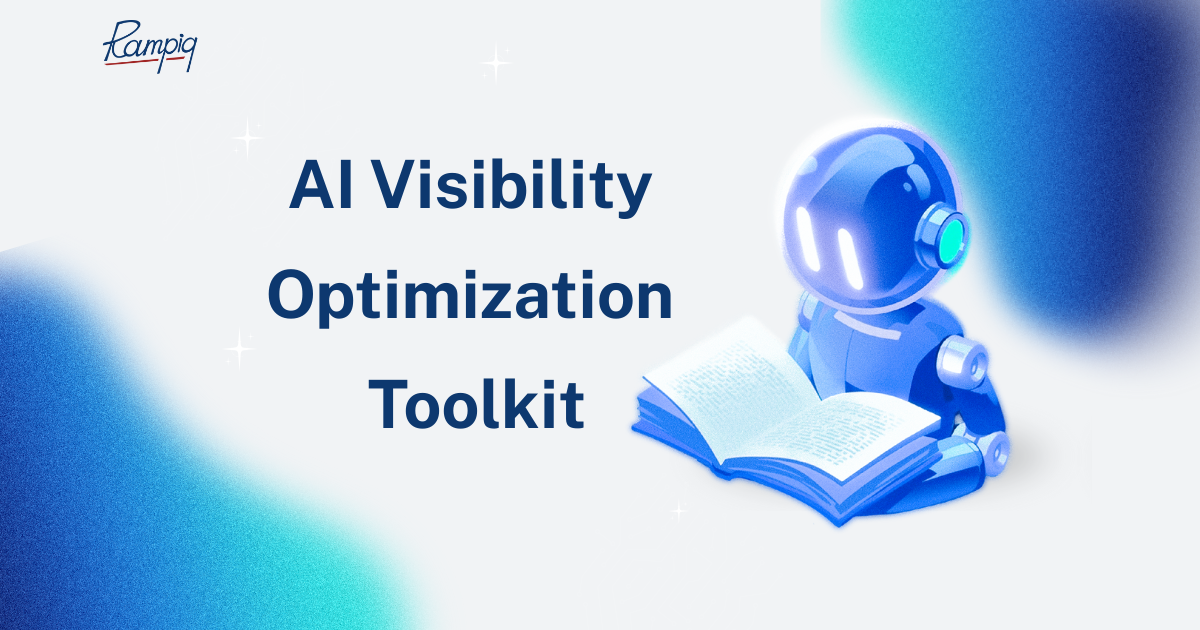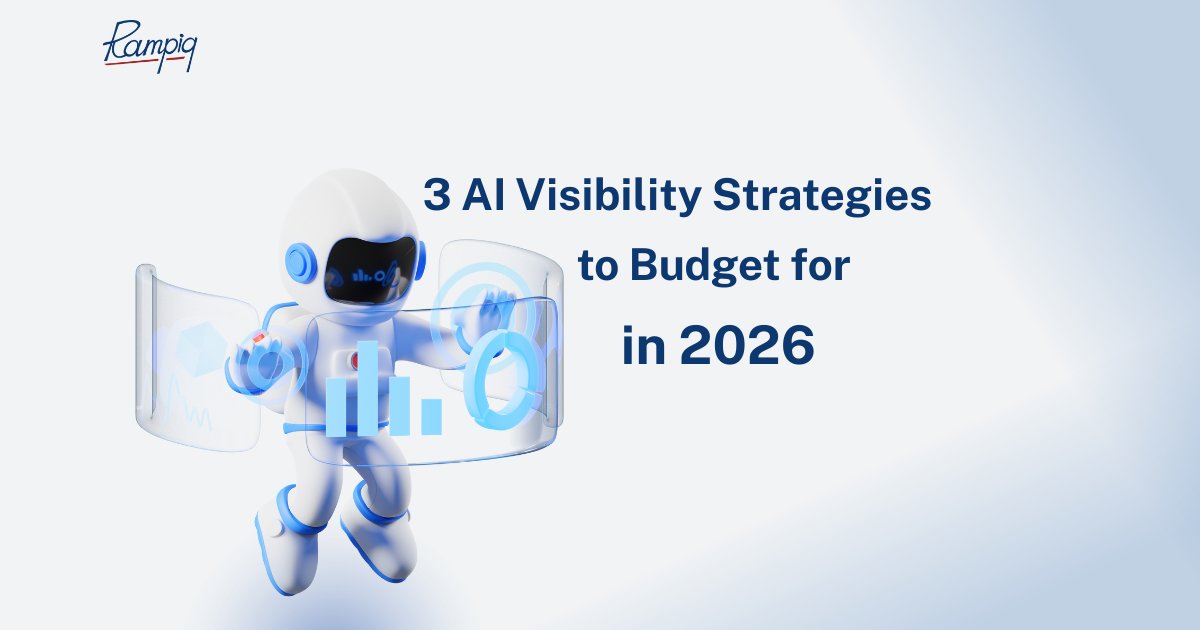Understanding 2024’s B2B SaaS SEO vs. B2C Differences
1. The B2B sales cycle
The sales cycle in the B2B sphere is typically much longer than it is for B2C companies. This could be months, or even years long.
2. Keyword targeting
Secondly, SaaS providers typically target very specific niches. This means your SEO strategy will often have to be optimized for low, or even zero-volume keywords.
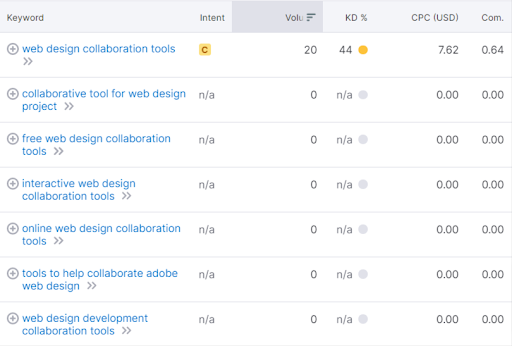 3. The importance of your expertise
3. The importance of your expertise
Successful SaaS businesses are those that have built trust with their client base. Much of your SEO strategy will therefore be building up the content that enables your customers to learn about and trust you, and build respect for you as an expert in your field.
It is vital that you use every possible means to maximize your brand visibility and make your voice heard:
- Blogging
- LinkedIn posts
- Video marketing
- Podcasts
The importance of having a growth-focused SEO strategy
Devising a successful strategy demands time, effort, and patience. A good SEO strategy aligns your SEO goals and business goals. Before you invest your resources in this process, it is a good idea to have an appreciation of what you stand to gain.
1. Increased visibility
A well-executed SEO strategy improves the visibility of your products in search engine results, increases traffic to your website, and attracts the right customers. If you promote your content, you also bring referral and social media traffic to your website. In short, a well-crafted SaaS SEO strategy yields highly relevant users, leading to more leads and sales, in an accelerated period of time.
2. Long-term results
Unlike paid advertising, which stops working when you stop paying for it, SEO can provide long-term benefits. By investing in SEO, you can establish a strong online presence that will continue to generate traffic and leads for your SaaS product over time.
3. Thought leadership
A well-executed SEO strategy also helps you build your reputation as a trusted thought leader in your niche. Publishing original content based on real-world cases, and addressing the pain points of your typical buyers, as well as providing insightful answers to pressing questions cements your status as an expert that can be trusted.
4. Complements other channels
An effective SEO strategy also helps bring traffic to your website in addition to that coming in from your other channels. You achieve this by improving the performance of your landing pages and creating content that you can promote on your other channels, like email and social media. By using an effective SEO strategy to drive traffic – paid and organic – to your website, and getting more backlinks and social shares, you increase the visibility of your brand, get more out of your paid campaigns, and boost organic traffic.
Personas and problems
A buyer persona answers the ‘who’ question. It’s a profile you create of an ideal consumer, and the result of market research where you study your target audience’s characteristics, habits, and needs, and identify similar patterns and preferences among them.
In the B2C space, the ‘who’ is relatively straightforward – it is the end-consumer of your product. If you’re selling school supplies, for example, you’re probably looking for school pupils and their parents.
It becomes a little more tricky for B2B, particularly SaaS. Your target is a company, not an individual. You need to figure out who the relevant decision-maker in that company that you need to reach is. Is it the CFO, a team lead, a product manager, or somebody else? You then determine how best to reach them.
A great way to do this is to conceptualize this in terms of personas and problems. Your target decision-maker will be looking for a way to solve a challenge they’re facing, this could be using software, some sort of technology, or some service that they are willing to pay for.
In EdTech for instance, you might offer a platform that helps educational institutions meet learning outcomes. So your target audience will be people like data coaches, curriculum directors, and policy-makers at School, District, and State levels. For SaaS in particular, you want to show them that the software you offer is the right fit for them and that you are a trustworthy expert in that field.
Read about how we created a growth plan for the EdTech company AnalyticVue that resulted in 562% growth in organic users.
Setting SMART goals and objectives
Just as important as your SaaS SEO strategy are the principles that guide your planning. You need a precise and organized framework for creating and attaining goals. Adhere to the SMART criteria when mapping out your strategy. Each of your objectives should be specific, measurable, attainable, relevant, and time-bound.
This approach will help you focus efforts and resources, promote accountability, track progress toward the outcomes you have set out, and keep you and your team motivated along the way.
Keyword research and niche analysis
With your buyer persona worked out, the next step is meeting your target audience in the places where they are searching. In SEO funnel terms, this means working out your bottom-of-the-funnel keywords. Broadly, the keywords will be divided into commercial and informational ones.
- Commercial or transactional intent keywords
Commercial keywords are queries that should lead to a transaction. For example, a user might look for “affordable hiking gear near me.”
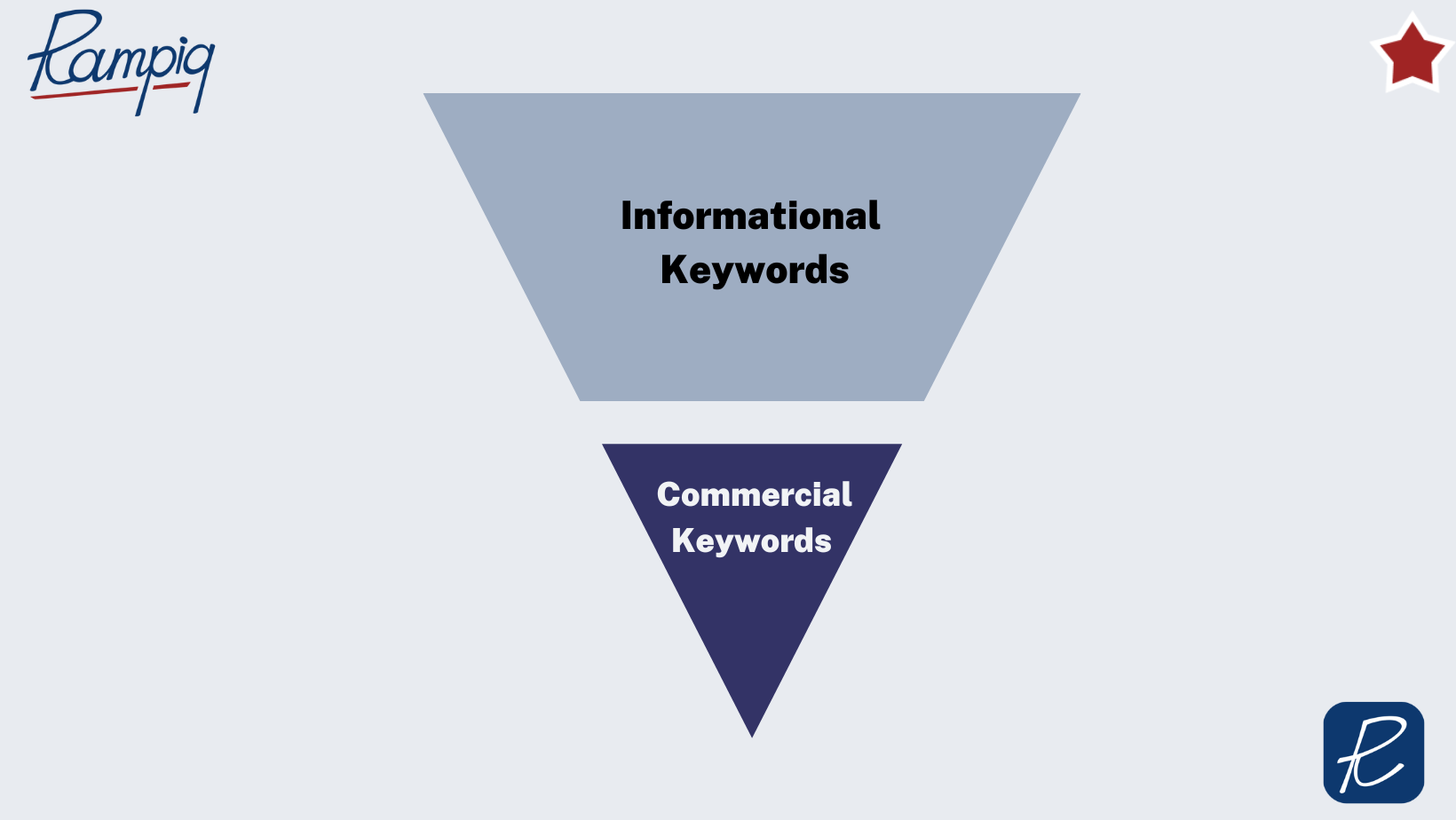 For B2B, these keywords relate more to business-related products and services. For example, “CRM integration services” is more transactional than “What is a CRM?”
For B2B, these keywords relate more to business-related products and services. For example, “CRM integration services” is more transactional than “What is a CRM?”
Start building your strategy with commercial keywords. What are your personas – the decision-makers you are targeting – searching for?
Typically, the keywords will likely relate to
- Software
- Tools
- Platforms
- Pricing
- Reviews
- Ratings
So, you have to optimize your landing pages with these commercial keywords.
- Informational or educational intent keywords
The second stage of your keyword research involves searching for informational keywords – words that are used when searching for information to educate, or help a user solve a specific problem. Such keywords help build trust and authority in your niche as they support the commercial-intent keywords.
While you research informational keywords, we recommend that you don’t go overly educational. Hence, try to avoid publish “What is” posts and going for “How to” guides or “Benefits of,” “Challenges of,” and comparisons.
Search your keyword tools for questions related to your seed keywords and don’t worry if these are low, or zero-volume keywords, as long as they fit your criteria.
Spy on Your SERP Competitors’ Keywords
Trying to outperform your competitors on keywords they already rank for can be a great start to your SEO strategy as it will guide you on what is already working with the audience you are targeting. Understanding what your direct competitors are ranking for is therefore key.
There are many tools you can use to find your competitor’s keywords. Try using the ‘Domain Explorer’ feature offered by keyword research tools like SEMrush, Ahrefs, or MOZ.
The key thing to note here is that your SERP competitors may be different from your business competitors. For example, a business blog can be a SERP competitor of a digital marketing agency that publishes articles on marketing metrics, but they are far from business competitors. We will discuss more on SERP competitors in the Find Quick Wins and Research the SERPs sections below.
By SERP competitors, we refer to the websites that share similar keywords with your website, as well as similar domain metrics. You are looking to identify websites that publish the same types of content as yours and have similar or worse domain metrics than your website. In theory, if you can produce higher quality content for keywords such websites rank and get traffic for, your page stands a chance to outperform theirs.
Keyword Gap Analysis
Carry out a keyword gap analysis to see where you are compared with your competitors. Keyword gap analysis is the process of identifying keywords that your competitors are successfully targeting and you are not. Building a winning SEO strategy requires that you identify those gaps in order to close them.
Ultimately, you want your website to be a complete source of the most relevant information in your niche. The Keyword Gap tool helps you analyze which keywords are sending traffic to you versus your competitors. It’s an invaluable way to:
- Uncover keyword opportunities that you are missing out on,
- Optimize your content with additional keywords to target,
- Generate new content ideas,
- Better understand your audience’s interests.
Find Quick Wins
This is the low-hanging fruit of keyword research – identifying and targeting keywords that have high search volumes, but are relatively easy to rank for. Such keywords have the potential to provide an immediate boost in the website’s rankings and visibility on search engines.
Be wary of depending solely on SEO tools like Ahrefs, Semrush, and Moz, as they very often provide incorrect keyword data such as search volumes and traffic-to-page. These figures should always be treated as mere estimates – sometimes from sources that no longer provide data (Avast, for example, stopped in 2020).
Also bear in mind that practically everyone uses these keyword tools, so your quick wins strategy will require a different approach to get you ahead. Let’s take a look at a few different ways of identifying quick wins:
- Checking SERPs
- Competitor keywords spying
- Forums and UGC keywords
Research the SERPs
The fastest way to identify quick wins is by using the Chrome browser with the Ahrefs SEO Toolbar extension installed. Download and add the extension to your browser, and follow these steps:
- Take note of your website’s key metrics, especially the Ahrefs Domain Rating (DR)
- Search for a keyword in Google search
- Check the top five results on the first page of the search results.
The Ahrefs extension will display an overview of the websites’ metrics. If you observe the following on the first page, this keyword could be a quick win:
- The average DR and backlinks of the domains in the top five spots is less than the DR of your website
- User-generated content (Quora, Reddit, forums, social media post, etc) on the first page
- Results on the first page that are not relevant to the query
Forums and User-Generated Content
Forums are goldmines for topics that users in the niche are curious about. They address problems and pain points. The threads typically have no coherent information flow, and no well-structured articles with H1, H2 titles, and so on. Nevertheless, they still get lots of organic traffic.
If a forum site with essentially no SEO can rank for a topic, a well-optimized, well-structured article on the subject should certainly rank too. So do the following:
- Perform a Google search for “[your niche] + forum” and identify the top 2-3 reputable forums in your niche,
- Put any of these forum home page links in the Ahrefs Site Explorer,
- Go to the ‘Top Pages’ tab on the left and see which of the pages are getting the highest traffic,
- Read through the threads and their replies and perform additional research on related topics to enable you to write a comprehensive article.
Alternatively, you can harvest keywords from popular forums by starting, not with your niche, but with the popular forums you know. Many popular forums usually have high SEO metrics, but you can take advantage of even an industry-average Domain Rating – with a well-written post – to outrank the forum threads.
Use this method to compete on keywords with any website with domain metrics that you’re sure you can outrank. Here’s how you can go about getting your keywords:
- Go to Ahrefs Site Explorer tab and search for the domain of the platform – Quora.com, for example,
- Click Keywords to view the keywords the platform ranks for,
- Identify niche keywords that have Quora pages ranking in the first five positions and drawing traffic,
- Filter the results accordingly,
- Sort the results by Traffic.
On-site SEO
Incorporate target keywords in the title
It is critical for on-page SEO that you put the keywords you need in your title tag. Google heavily relies on them to figure out what your website is about. You want to use the target keyword or some variant of it in the title tag of your website or blog. Even better – start your title tag with the keywords
Create a powerful Meta Description
The meta description is the brief text that appears below the title on the search results page. It is an important aspect that influences the number of visitors that navigate to your website from the search results page – the Click-Through Rate (CTR).
Writing an engaging, keyword-rich meta description is essential since it helps visitors understand what your content is about, and directly influences their decision to visit your website.
Keyword-rich meta descriptions are also great for SEO because Google crawlers – not just your potential site visitors – use the information there to better understand your content.
Optimize Headings, Subheadings, and Content Body
Other than titles, meta descriptions, and URLs, you should also align your website pages’ headers, subheadings, and other content with your target keywords. Google takes these keywords added to these elements into account when assessing your content, meaning there is plenty of potential for your content to rank higher on search engines.
Use a blend of short-tail keywords, long-tail keywords, and Latent Semantic Indexing (LSI) keywords when optimizing your content. Using multiple keyword variants enables Google crawlers to interpret and evaluate your content better.
READ ALSO: The Anatomy of a Good SEO Program: All You Need to Know
Add Internal and External Links
Ensure that you link internally relevant pages and that the most important pages have the largest number of incoming links. Also, add outgoing links to reputable and authoritative sources.
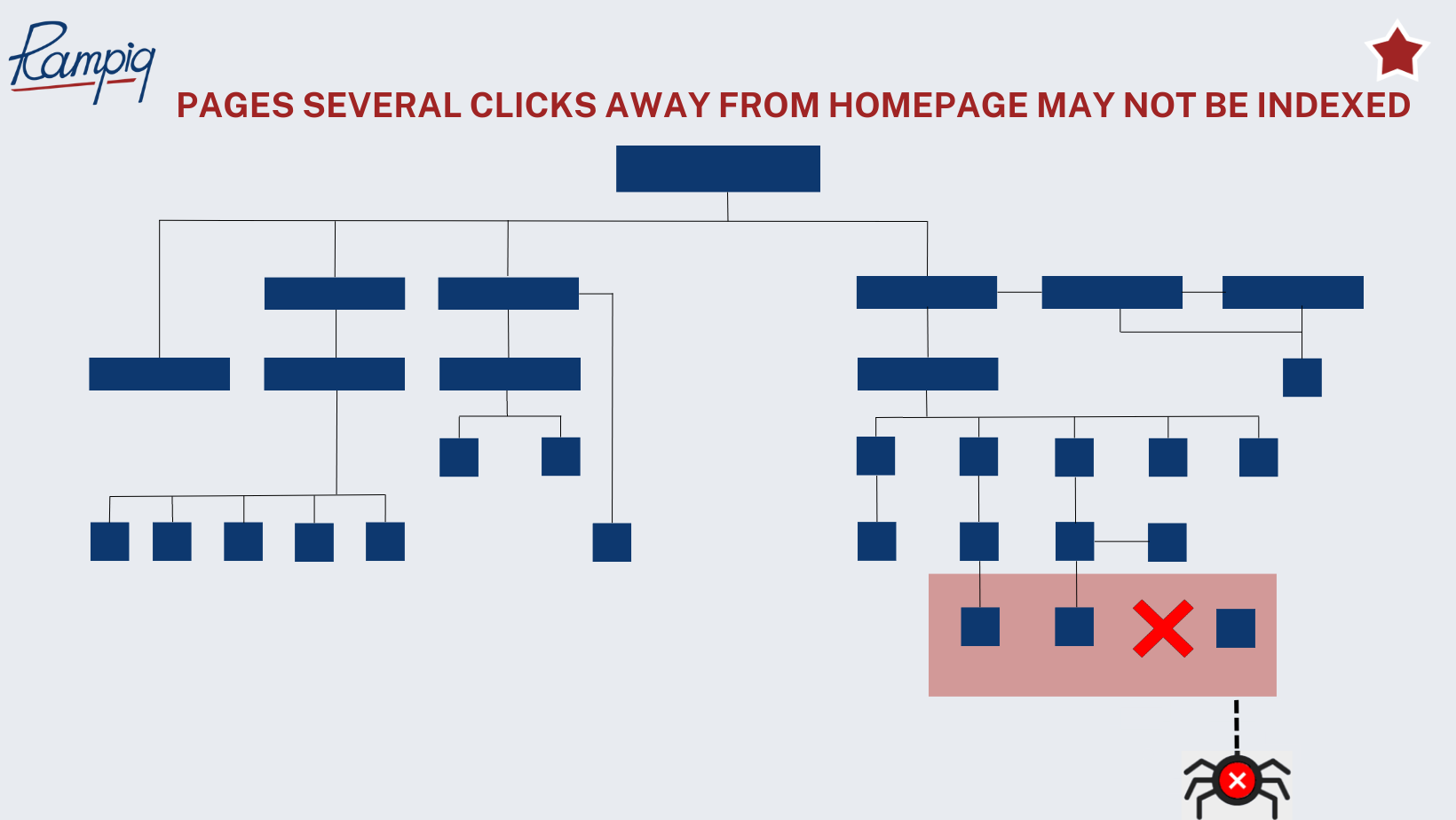 Internal links are of utmost importance because, firstly, they provide a better user experience, as users can easily navigate to pages that explain concepts in more detail or a page that is a logical next step in the buyer’s journey. Hence, ensure that the internal linking is purposeful and the links are not random but lead to an expected page. Furthermore, ensure that there are no orphan pages on your website.
Internal links are of utmost importance because, firstly, they provide a better user experience, as users can easily navigate to pages that explain concepts in more detail or a page that is a logical next step in the buyer’s journey. Hence, ensure that the internal linking is purposeful and the links are not random but lead to an expected page. Furthermore, ensure that there are no orphan pages on your website.
For external links, you should refer users to high-quality websites that contain original research or more information that back up your claims. Unlike one may believe, external links when done properly will not water down the authority of your page but instead, improve its authoritativeness. However, you must note that different link types would affect the pages differently.
Dofollow links should be used when pointing your user to a high-authority web page that is not in competition with yours because such links are followed and pass link equity. On the other hand, you may use nofollow and other link types when you are only linking out of necessity. For instance, sponsored content (use the sponsored tag), affiliate links, etc.
Implement User-Friendly Site Architecture and Navigation
An optimized site architecture not only delivers a better user experience by making it easier to browse your website and locate information quickly and effortlessly, but crucially, it also makes it easier for search engine spiders to find and index the pages on your site.
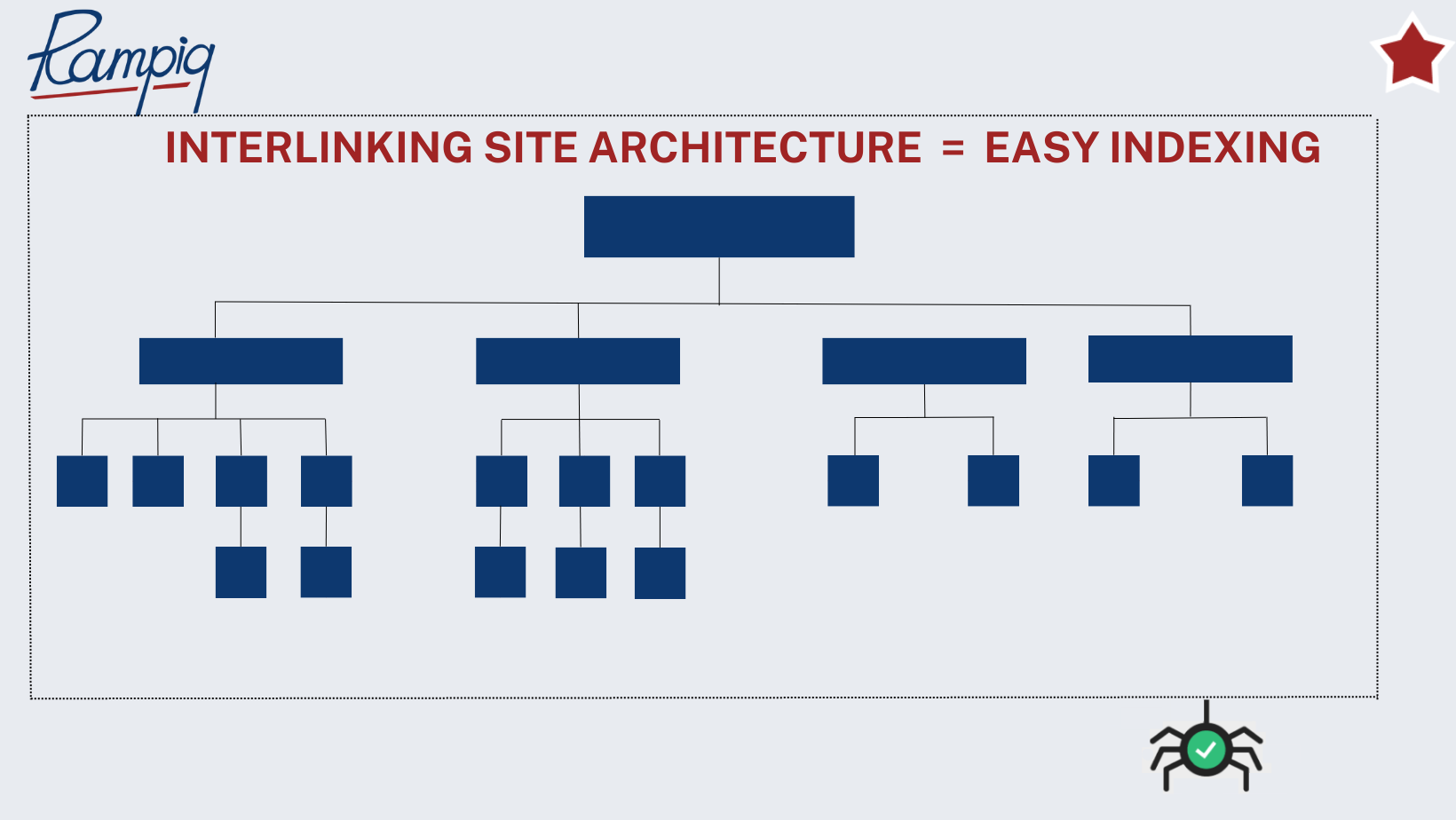
A clear and ordered structure with internal links improves your overall rating in search results. If you have pages on your site that are several clicks away from your homepage (or not linked from any other page at all), Googlebot will have a difficult time discovering and indexing such pages. This will harm your SEO and the success of your website.
We recommend creating a flat architecture where users can reach any page on your site in four clicks or less. This approach also enables Google spiders to find all the web pages on your site, maximizing your Crawl Budget.
Content Promotion
Merely generating great content is often not enough to ensure that people discover and connect with it, you also need to promote it on other platforms. This could be by sharing your content on social media, reaching out to other blogs or websites to feature your content, and using paid advertising. This helps you extend your reach and attract new users.
To carry out off-page promotion, you need to research your competitors and your niche to find out:
- What platforms are a must in this niche (this might be technical directories, product listings, product reviews, and so on.)
- How aggressive are your competitors in terms of link building: how many links do they get monthly? On what platforms?
- What is the benchmark for off-page promotion in this niche – how many links do you need to get to catch up with your competition or outperform them?
You can then promote your content in the following ways:
- Acquire backlinks from relevant authoritative websites,
- Send emails to leads and customers,
- Plan and schedule your content on LinkedIn and Facebook,
- Post in relevant groups,
- Ask your network influencers to share your content,
- Create a new list of influencers and ask them to share,
- Add social sharing buttons,
- Promote your content using external guest posts,
- Set up a paid campaign for key blog posts that are more likely to bring in leads.
Content marketing
It is sometimes tempting to think that publishing educational pieces is essentially just freely revealing trade secrets. However, the result is in fact the opposite: you do not lose your competitive edge, you instead build one.
The ultimate goal of content marketing is to get your customers – by offering them value – to take some action over time like making a purchase or signing up for a service.
Developing adaptable content that addresses consumers’ issues will also help your company in ways other than marketing. Providing knowledge that tackles frequently asked questions can help alleviate your staff of the stress of answering the same inquiries from different consumers.
Content marketing is also worth investing in for SaaS business because:
- By publishing content that describes how well your product helps your customers to deal with their pain points, you boost your products’ discoverability,
- You build topical authority which helps you rank higher with Google as it is one of Google’s EEAT factors (Experience, Expertise, Authoritativeness, and Trustworthiness),
- Content Establishes Your Authority as a Thought Leader,
- Content marketing is a great way to nurture leads by providing them with targeted material that answers their individual requirements and interests, while also creating trust and credibility,
- Content that appeals to the needs and interests of the target audience enhances the possibility of converting leads into customers.
Tracking and Analytics
Tracking and analytics are crucial pieces of the B2B SaaS SEO strategy. They offer insights into how effective SEO efforts are and by collecting data on website traffic, engagement metrics, and user behavior, provide a platform from which companies can make informed decisions about how to hone their digital marketing initiatives.
Utilize tracking tools to monitor key performance indicators, including organic traffic, bounce rate, and conversion rates, to identify areas that require improvement and track the ROI of SEO campaigns and make adjustments based on real-time data. This will offer you the tools to build a competitive edge while revealing possibilities for future growth opportunities.
Increasing the Effectiveness of Your B2B SaaS SEO Funnel
The key to optimizing your B2B SaaS SEO funnel is to ensure that your website or landing page systematically navigates users from the top of the funnel to the bottom. This can be achieved by ensuring:
- You have an internal links structure that navigates users from one page to another and moves them closer and closer to the bottom of the funnel and conversion
- You have enough relevant content for each stage:
| Stage |
Type of content |
Purpose of the content |
| Top of the funnel |
Blog posts
Guides
Infographics
Videos
Podcast
LinkedIn posts |
Instead of trying to sell your products or services, enlighten your target users about their challenges and alternative ways of resolving them.
Respond to as many questions as possible from your audience and demonstrate how your product or service provides the solution. |
| Middle of the funnel |
Pros vs cons lists
Comparison lists
Top lists of alternatives
Checklists
Templates
In-depth guides
Case studies
Customer testimonials
Reviews |
Showcase your products as a solution to the customers’ pain points
Prove your product’s advantages over other competitors |
| Bottom of the funnel |
Detailed product guides
Product demo
Product how-tos
Explanatory videos
Detailed explanations of plans and prices |
Demonstrate, with proof and examples, how your product can solve specific challenges |
Benchmarks for B2B SaaS SEO Success
Use the following metrics as indicators to assess the level of success of your strategy, and to set goals, monitor progress, and identify areas for improvement:
- Keyword rankings: the position of your website’s pages in search engine result pages for specific search queries
- Conversion and conversion rate: the action that you want site visitors to take, like making a purchase, completing a form, or subscribing, and the proportion of visitors who actually complete this desired action.
- SERP visibility: how visible your page is in search engine result pages.
- Click-through rate: the rate at which users click on your website pages when they see them on search engine result pages.
- Website/domain authority: scores SEO tools use for predicting how well your website is likely to rank based on the ranking factors and domain metrics.
- Page speed: how long it takes your website to load completely.
- Time on site: how long visitors spend on your website.
- Pages per session: how many of your website pages, on average, visitors view per session.
- Referring domains and backlinks: the number of unique websites that link to yours.
- Return on investment (ROI): the cost of investment versus the revenue you get back.
PRO Tips for B2B SaaS SEOSuccess
Tip 1: Harvest demand
Harvesting demand is the practice where we identify and target keywords that are highly relevant to our content and have high search volumes.
Here’s a quick way to do this using the Google Search Console:
- Open the Google Search Console and navigate to Performance;
- Select a recent time frame (for example, 28 days);
- Go to the Pages tab and click on the page or filter URL for the page you want to explore and improve;
- Switch to the Queries tab;
- Check for the queries that you did not target intentionally but have impressions for, and a few clicks. Also consider their Positions;
- Disregard whatever your keyword tool says about that query, and go back to your page and optimize it for this keyword;
- Look at titles, meta descriptions, and so on;
- Use the keyword in an H2 or H3 subheading or in the FAQ section.
READ ALSO: Forecasting SEO Traffic and ROI for SaaS Businesses
Tip 2: Target Zero-Volume Keywords if They Fit Other Criteria
This might seem counterintuitive at first. But consider the following:
- Less competition for keywords means there is a better chance to rank for that term with unique, thoughtful, optimized content.
- Zero-volume keywords are typically highly relevant to your audience but are not often covered by unique, thoughtful content, creating an opportunity for your business.
- By a Google estimate, 15% of queries in Google have never been asked, that’s up to 15% of potential traffic for you. Provided that there is little high-quality content for zero-volume keywords, you are highly likely to attract that traffic.
Tip 3: Links Are Still Important but Getting Links That Matter is Getting Harder
Google is still counting links as votes of trust. But not all links are created equal. With the introduction of the Link Spam Update, Google can easily detect links created for the sake of links. To have your links counted we have the following recommendations:
- Don’t solicit links: It is super easy to detect links created for promotional reasons. Thus these links will be just ignored by search engines.
- Build relationships: It is getting harder and harder for cold outreaches to work. Instead, we recommend building relationships with site owners or editors on their websites, Linkedin or Twitter, for example. Find them, follow them, like their posts, and leave comments. Try to build genuine relationships before you start asking for a link back or social share.
- Create link magnets: If you were an editor what type of content would you link back to? This might be some research, statistics, an interview with an influencer, a unique case study, etc. Put yourself in the editors’ shoes, research the content they may need, and create it for them. It doesn’t mean that every piece of content should be created for this purpose but you should definitely include some in your content plan.

 3. The importance of your expertise
3. The importance of your expertise For B2B, these keywords relate more to business-related products and services. For example, “CRM integration services” is more transactional than “What is a CRM?”
For B2B, these keywords relate more to business-related products and services. For example, “CRM integration services” is more transactional than “What is a CRM?” Internal links are of utmost importance because, firstly, they provide a better user experience, as users can easily navigate to pages that explain concepts in more detail or a page that is a logical next step in the buyer’s journey. Hence, ensure that the internal linking is purposeful and the links are not random but lead to an expected page. Furthermore, ensure that there are no
Internal links are of utmost importance because, firstly, they provide a better user experience, as users can easily navigate to pages that explain concepts in more detail or a page that is a logical next step in the buyer’s journey. Hence, ensure that the internal linking is purposeful and the links are not random but lead to an expected page. Furthermore, ensure that there are no 


